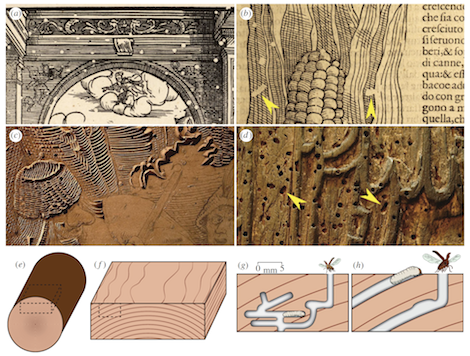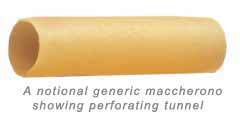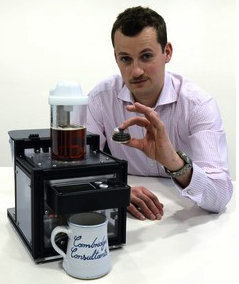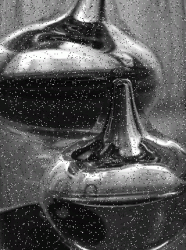Marc Abrahams's Blog, page 532
November 30, 2012
Worm-generated wormholes record history in space and time
Wormholes — what are they good for? This study suggests one possible answer:
“Wormholes record species history in space and time,” S. Blair Hedges, Biology Letters, vol. 9, no. 1. February 2013. The author, at Penn State University, reports:
“I show that printed wormholes in rare books and artwork are trace fossils of wood-boring species with unusually accurate locations and dates. Analyses of wormholes printed in western Europe since the fifteenth century document the detailed biogeographic history of two putative species of invasive wood-boring beetles. Their distributions now overlap broadly, as an outcome of twentieth century globalization. However, the wormhole record revealed, unexpectedly, that their original ranges were contiguous and formed a stable line across central Europe, apparently a result of competition. Extension of the wormhole record, globally, will probably reveal other species and evolutionary insights. These data also provide evidence for historians in determining the place of origin or movement of a woodblock, book, document or art print.”

(Thanks to investigator Megan Juarez for bringing this to our attention.)
BONUS: A different kind of wormhole, and its relation to space and time

Updated index of new patents for golfballs (Nov. 2012)
 November 2012 saw a higher-than-average number of golfball-related patents issued by the US Patent and Trademark Office. There were no less than 11 new golfball concepts – an improvement of nearly 38% on last month’s lacklustre figures.
November 2012 saw a higher-than-average number of golfball-related patents issued by the US Patent and Trademark Office. There were no less than 11 new golfball concepts – an improvement of nearly 38% on last month’s lacklustre figures.
• Golf ball having moisture barrier layers made from polyolefin compositions
• Multilayer core golf ball having hardness gradient within and between each core layer (1)
• Multilayer core golf ball having hardness gradient within and between each core layer (2)
• Golf balls having a low modulus HNP layer and a high modulus HNP layer (1)
• Golf balls having a low modulus HNP layer and a high modulus HNP layer (2)
• Multilayer core golf ball having hardness gradient within and between each core layer (3)
• Multilayer core golf ball having hardness gradient within and between each core layer (4)
• Multilayer core golf ball having hardness gradient within and between each core layer (5)
• Golf ball dimples having circumscribed prismatoids

“Is everything we eat associated with cancer?”
A new study looks at a plethora of glancing looks at cause and effect. The study is:
“Is everything we eat associated with cancer? A systematic cookbook review,” Jonathan D Schoenfeld and John PA Ioannidis, Amercian Journal of Clinical Nutrition, epub November 28, 2012. The authors report:
Objective: We aimed to examine the conclusions, statistical significance, and reproducibility in the literature on associations between specific foods and cancer risk.
Design: We selected 50 common ingredients from random recipes in a cookbook. PubMed queries identified recent studies that evaluated the relation of each ingredient to cancer risk. Information regarding author conclusions and relevant effect estimates were extracted. When >10 articles were found, we focused on the 10 most recent articles.
Results: Forty ingredients (80%) had articles reporting on their cancer risk. Of 264 single-study assessments, 191 (72%) concluded that the tested food was associated with an increased (n = 103) or a decreased (n = 88) risk; 75% of the risk estimates had weak (0.05 > P ≥ 0.001) or no statistical (P > 0.05) significance. Statistically significant results were more likely than nonsignificant findings to be published in the study abstract than in only the full text (P < 0.0001). Meta-analyses (n = 36) presented more conservative results; only 13 (26%) reported an increased (n = 4) or a decreased (n = 9) risk (6 had more than weak statistical support). The median RRs (IQRs) for studies that concluded an increased or a decreased risk were 2.20 (1.60, 3.44) and 0.52 (0.39, 0.66), respectively. The RRs from the meta-analyses were on average null (median: 0.96; IQR: 0.85, 1.10).
Conclusions: Associations with cancer risk or benefits have been claimed for most food ingredients. Many single studies highlight implausibly large effects, even though evidence is weak. Effect sizes shrink in meta-analyses.
(HT Ed Yong)
BONUS: Jane Siberry’s “Everything Reminds Me of My Dog”:

November 27, 2012
Heidegger meets Macaroni in New York State
 • Which came first, the hole or the macaroni?
• Which came first, the hole or the macaroni?
• And what would Heidegger have had to say about it?
These questions have been examined in some detail by professor Gregg Lambert of Syracuse University, New York state. As readers may know (via his personal website) “Professor Lambert is internationally renowned for his scholarly writings…” and in this capacity he provides an article for the scholarly journal SubStance, 2003; 32 (1)
“What Questions Fascinate Me?” “What do I Want to Know?”
Questions are raised – such as “How are you Today?” and, especially, “The Question of Macaroni”.
“The Question of Macaroni: The belief that the question is a form of causality can be classified as an illusion, somewhat like the famous transcendental illusion concerning the macaroni: if macaroni is the pasta shell shaped around an empty center, then who first shaped the empty center?”
“If there is an essential illusion that conditions the appearance of the question, it may be because it can only address the nothingness that is always already at the center of both the being of the questioner and the being in question.”
“Which came first, the hole or the macaroni? We could also ask whether the question itself only refers to the hole in the real—that is, to the presence of a subject. Thus, “the question of the thing” (Das Ding) continues to interest me, but in a very different manner than taken up by Heidegger. Take, for example, the emptiness of the jug, in which the sky and the earth are united in the religious act of oblation (offering, sacrifice). Heidegger would never have raised the macaroni to the dignity of the Thing, and so it is apparent that Heidegger was only interested in certain things, and this skewed his understanding of things in general.“
“The sky and the earth do not come together in the middle of the macaroni, but then, this does not mean that the hole in the macaroni is purely accidental, like a secondary attribute, since its presence is what makes a macaroni a macaroni, which is to say that lacking this infamous hole, it would be a Swedish meatball.”
Notes:
Macaroni (a.k.a Maccheroni) is not the only pasta-type to manifest topologically coherent single holes. Examples include (but are not limited to) :
Also see : Raccette which features multiple holes.
Improbable link-trail for further reading around holes : here

Self-Esteem of Steamy Actresses: High There
Further findings on the self-esteem front:
“Pornography Actresses: An Assessment of the Damaged Goods Hypothesis,” James D. Griffith, Sharon Mitchell, Christian L. Hart, Lea T. Adams and Lucy L. Gu, Journal of Sex Research, epub November 20, 2012. The authors explain:
“The damaged goods hypothesis posits that female performers in the adult entertainment industry have higher rates of childhood sexual abuse (CSA), psychological problems, and drug use compared to the typical woman. The present study compared the self-reports of 177 porn actresses to a sample of women matched on age, ethnicity, and marital status. Comparisons were conducted on sexual behaviors and attitudes, self-esteem, quality of life, and drug use. Porn actresses were more likely to identify as bisexual, first had sex at an earlier age, had more sexual partners, were more concerned about contracting a sexually transmitted disease (STD), and enjoyed sex more than the matched sample, although there were no differences in incidence of CSA. In terms of psychological characteristics, porn actresses had higher levels of self-esteem, positive feelings, social support, sexual satisfaction, and spirituality compared to the matched group. Last, female performers were more likely to have ever used 10 different types of drugs compared to the comparison group. A discriminant function analysis was able to correctly classify 83% of the participants concerning whether they were a porn actress or member of the matched sample. These findings did not provide support for the damaged goods hypothesis.”
(Thanks to investigator Ron Josephson for bringing this to our attention.)

November 26, 2012
“Tables and chairs on the highway”
The phrase “Tables and chairs on the highway” has a uniformly accepted meaning in all of England and Wales. That meaning is legalistic, deriving, we are told, from part VIIA, section 115 (A to K) of the Highways Act 1980, a chunk of parliamentary prose that has the title Provision of Amenities on Certain Highways. In describing those amenities, though, it makes no mention – none at all – of chairs or tables or any other kind of common furniture. The phrase “Tables and chairs on the highway” appears nowhere – nowhere – in Highways Act 1980.
Nevertheless, many regional and local authorities proclaim that part VIIA, section 115 (A to K) of the Highways Act 1980 – devoid though it is of tables and chairs – gives them authority to regulate all aspects of civic life that are covered by the phrase “Tables and chairs on the highway”.
Regulate it they do.
Chelmsford borough council publishes a document called Guidelines for Placing Tables and Chairs on the Highway under Section 115 Part VIIA of the Highways Act 1980….
So begins this week’s Improbable Research column in The Guardian.

Transplanting Beavers by Airplane and Parachute
Perhaps the first formal study of transplanting beavers by airplane and parachute appeared slightly more than six decades ago:
“Transplanting Beavers by Airplane and Parachute,” Elmo W. Heter, Journal of Wildlife Management, vol. 14, no. 2, April 1950, pp. 143-7. The Atlantic did a nice piece about it, as did The Daily Planet. The author, at the Idaho Fish and Game Department, McCall, Idaho, reports:
“The best altitude for launching is between 500 and 800 feet. This height assures sufficient time for the ‘chute to set the box down gently. Yet, it is low enough for accuracy in placing the box in the selected meadow, and to avoid trees or other obstacles in which the ‘chute and box might become entangled.
“Satisfactory experiments with dummy weights having been completed, one old male beaver, whom we fondly named ‘Geronimo,’ was dropped again and again on the flying field. Each time he scrambled out of the box, someone was on hand to pick him up. Poor fellow! He finally became resigned, and as soon as we approached him, would crawl back into his box ready to go aloft again.”
The image below, from the study, shows the box in which the beaver rode.
(Thanks to Dan Eastwood for bringing this to our attention.)
BONUS: Patent for another box by Elmo Heater, designed for a different kind of task.
BONUS: “Grey Owl’s Strange Guests”, a 1936 documentary film about beavers:
BONUS (unrelated): “Go Parachuting Near Beaver! Are you ready to jump out of an airplane high above Beaver?”
BONUS: The project that parachuted dead mice to a new home.

Another British tea innovation
 Britain gave the world many things. Among those are deadpan delivery, Heath Robinson, and a fascination for detailed methods of brewing tea.
Britain gave the world many things. Among those are deadpan delivery, Heath Robinson, and a fascination for detailed methods of brewing tea.
Those three gifts are combined in the “revolutionary approach to the gentle art of making tea” announced recently by a firm called Cambridge Consultants. Behold their demonstrative video:
(Thanks to investigator Robinj for bringing this to our attention.)
BONUS: The British fascination for tea has also produced several Ig Nobel Prizes.

November 25, 2012
Things that sneak into the literature: Stuperspace
Odd bits of concoction occasionally find their way into otherwise somber research journals. Here’s one example:
“Stuperspace,” V. Gates, Empty Kangaroo, M. Roachcock, Physica D: Nonlinear Phenomena, vol. 15, nos. 1–2, February 1985, pp. 289–293. The abstract says:
“We prove, once and for all, that people who don’t use superspace are really out of it. This includes QCDers, who always either wave their hands or gamble with lettuce (Monte Zuma calculations). Besides, all nonsupersymmetric theories have divergences which lead to problems with things like renormalons, instantons, anomalons, and other phenomenons. Also, they can’t hide from gravity forever.”
BONUS: By the same authors: “Super G-String Field Theory“, and many more.

There’s more to salt & pepper than meets the eye

Salt and pepper noise – Image from Wikimedia Commons
Salt and pepper can refer to many things other than the condiments — such as films, an album, a musical group, noise, etc. (Here is a relatively comprehensive list of things salt n’ pepper.) Some of those things are medical.
The eye is not an uncommon target for those who think about food while they work. Here is salt and pepper in the eye.
BONUS:
Oranges, pizza, cherries in the eye.

Marc Abrahams's Blog
- Marc Abrahams's profile
- 14 followers


















